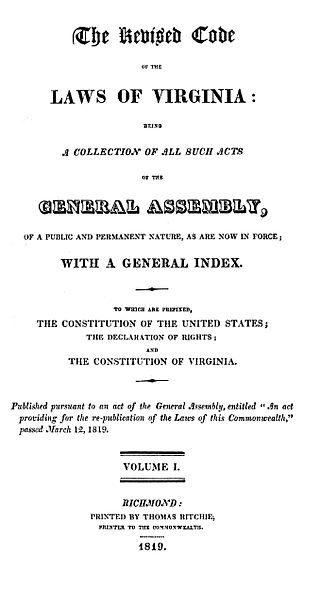
The United States Code is the official codification of the general and permanent federal statutes of the United States. It contains 53 titles, which are organized into numbered sections.

The primary and fundamental statement of laws in the Russian Federation is the Constitution of the Russian Federation. Statutes, like the Russian Civil Code and the Russian Criminal Code, are the predominant legal source of Russian laws.
A repeal is the removal or reversal of a law. There are two basic types of repeal; a repeal with a re-enactment is used to replace the law with an updated, amended, or otherwise related law, or a repeal without replacement so as to abolish its provisions altogether.

The Code of Virginia is the statutory law of the U.S. state of Virginia and consists of the codified legislation of the Virginia General Assembly. The 1950 Code of Virginia is the revision currently in force. The previous official versions were the Codes of 1819, 1849, 1887, and 1919, though other compilations had been printed privately as early as 1733, and other editions have been issued that were not designated full revisions of the code.

The Connecticut General Statutes, also called the General Statutes of Connecticut and abbreviated Conn. Gen. Stat., is a codification of the law of Connecticut. Revised to 2017, it contains all of the public acts of Connecticut and certain special acts of the public nature, the Constitution of the United States, the Amendments to the Constitution of the United States, and the Constitution of the State of Connecticut, including its 31 amendments adopted since 1965. The earliest predecessor to the currently in force codification dates to 1650.
The Ohio Revised Code (ORC) contains all current statutes of the Ohio General Assembly of a permanent and general nature, consolidated into provisions, titles, chapters and sections. However, the only official publication of the enactments of the General Assembly is the Laws of Ohio; the Ohio Revised Code is only a reference.

Law in the state of Louisiana is based on a more diverse set of sources than the laws of the other 49 states of the United States. Private law—that is, substantive law between private sector parties, principally contracts and torts—has a civil law character, based on French and Spanish codes and ultimately Roman law, with some common law influences. Louisiana is the only state whose private legal system is based on civil law, rather than the traditional American common law. Louisiana's criminal law, however, does largely rest on common law. Louisiana's administrative law is generally similar to the administrative law of the federal government and other states. Louisiana's procedural law is generally in line with that of other U.S. states, which in turn is generally based on the U.S. Federal Rules of Civil Procedure.

The California Codes are 29 legal codes enacted by the California State Legislature, which, alongside uncodified acts, form the general statutory law of California. The official codes are maintained by the California Office of Legislative Counsel for the legislature. The Legislative Counsel also publishes the official text of the Codes publicly at leginfo.legislature.ca.gov.

The Annotated Code of Maryland, published by The Michie Company, is the official codification of the statutory laws of Maryland. It is organized into 36 named articles. The previous code, organized into numbered articles, has been repealed.
The copyright status of works produced by the governments of states, territories, and municipalities in the United States varies. Copyright law is federal in the United States. Federal law expressly denies U.S. copyright protection to two types of government works: works of the U.S. federal government itself, and all edicts of any government regardless of level or whether or not foreign. Other than addressing these "edicts of government", U.S. federal law does not address copyrights of U.S. state and local government.
The law of Colorado consists of several levels, including constitutional, statutory, regulatory, local, and case law. The Colorado Revised Statutes form the general statutory law.
The law of Virginia consists of several levels of legal rules, including constitutional, statutory, regulatory, case law, and local laws. The Code of Virginia contains the codified legislation that define the general statutory laws for the Commonwealth.
The law of Texas is derived from the Constitution of Texas and consists of several levels, including constitutional, statutory, regulatory law, as well as case law and local laws and regulations.
The law of Illinois consists of several levels, including constitutional, statutory, and regulatory law, as well as case law and local law. The Illinois Compiled Statutes (ILCS) form the general statutory law.
The law of Pennsylvania consists of several levels, including constitutional, statutory, regulatory and case law. The Pennsylvania Consolidated Statutes form the general statutory law.
The law of Ohio consists of several levels, including constitutional, statutory, and regulatory, local and common law. The Ohio Revised Code forms the general statutory law.

The law of Michigan consists of several levels, including constitutional, statutory, regulatory and case law. The Michigan Compiled Laws form the general statutory law.
The law of Washington consists of several levels, including constitutional, statutory, regulatory and case law, as well as local ordinances. The Revised Code of Washington forms the general statutory law.
The following is the planned order of succession for the governorships of the 50 U.S. states, Washington, D.C., and the five organized territories of the United States, according to the constitutions of each. Some states make a distinction whether the succeeding individual is acting as governor or becomes governor.

Citation of Canadian legislation is the system of citing Canadian statutes and regulations in court decisions, briefs of law, and articles in law journals. The purpose of a citation is to allow the reader to understand the source of the legislative principle being cited, and to find the law in question. It is a type of legal citation, namely a "reference to a legal precedent or authority, such as a case, statute, or treatise, that either substantiates or contradicts a given position".










